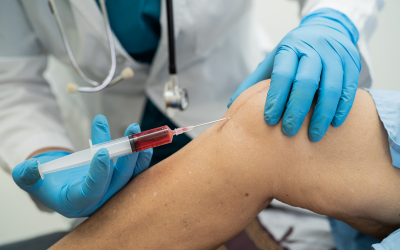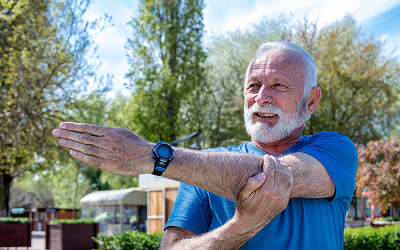Chronic joint pain can be debilitating, stealing your mobility and quality of life. For decades, the primary treatment options were physical therapy, medication, or invasive surgery. However, a revolutionary field of medicine—regenerative medicine for joint pain—is offering promising non-surgical joint pain relief options by harnessing your body’s innate ability to heal.
Two leading treatments in this field are Platelet-Rich Plasma (PRP) therapy and Stem Cell therapy. The choice between them—PRP vs stem cells for joint pain—depends entirely on the severity and nature of your condition.
Understanding the Basics of Regenerative Medicine
Regenerative medicine focuses on replacing or repairing damaged cells, tissues, or organs. Instead of masking pain with drugs (like cortisone shots) or surgically removing damaged tissue, these therapies aim to regenerate the injured area.
They use biological material—often derived from your own body (autologous)—to deliver a concentrated dose of healing components directly to the site of damage, promoting an accelerated and more robust natural healing response. This is the core principle behind regenerative joint treatments.
What is PRP Therapy?
PRP therapy for joint pain involves drawing a small sample of your own blood, similar to a routine blood test. This blood is then placed into a centrifuge, a machine that spins at high speed to separate the components. This process isolates the platelets and concentrates them in a small volume of plasma—creating Platelet-Rich Plasma.
Platelets are most famous for their role in blood clotting, but they are also packed with hundreds of potent growth factors and signaling proteins. When this concentrated solution is injected back into an injured joint or tissue (often guided by ultrasound for precision), the growth factors trigger a powerful local healing cascade.
The primary function of PRP is to dramatically boost the existing repair process, reduce inflammation, and stimulate local cells to begin repairing damaged tissue. It essentially provides a “super-boost” to your body’s natural healing mechanism.
Common Conditions Treated with PRP:
PRP is generally considered a first-line regenerative treatment for a variety of musculoskeletal issues, particularly those involving inflammation and mild to moderate tissue damage:
- Mild to Moderate Osteoarthritis (OA): Especially in the knee, hip, and shoulder, to reduce pain and inflammation and slow degeneration.
- Chronic Tendinopathies: Including Tennis Elbow (lateral epicondylitis), Golfer’s Elbow (medial epicondylitis), Achilles tendinitis, and Patellar tendinitis (Jumper’s Knee).
- Ligament and Tendon Sprains/Tears: Often used for non-surgical tears or chronic injuries that haven’t healed with traditional rest and physical therapy.
What is Stem Cell Therapy?
Stem cell therapy for joint pain is a more advanced procedure utilizing mesenchymal stem cells (MSCs). These “primitive” cells are undifferentiated, meaning they have the remarkable ability to transform into other types of specialized cells (like cartilage, bone, muscle, or fat) and self-replicate.
In the context of joint repair, MSCs are typically harvested from the patient’s own body—most commonly from bone marrow (Bone Marrow Aspirate Concentrate or BMAC) or adipose (fat) tissue. The harvested tissue is processed to concentrate the stem cells, which are then injected into the damaged joint.
Unlike PRP, which focuses on stimulating existing cells to heal, stem cell therapy provides the actual “building blocks” (the stem cells) that can potentially replace severely damaged or lost tissue.
Furthermore, stem cells release anti-inflammatory and immunomodulatory factors, creating a favorable environment for regeneration and pain relief.
Common Conditions Treated with Stem Cells:
Due to their powerful regenerative and tissue-building potential, stem cells are often reserved for more severe, chronic, or degenerative conditions:
- Moderate to Severe Osteoarthritis (OA): Where significant cartilage loss or chronic joint degeneration has occurred.
- Avascular Necrosis (AVN): A condition resulting from the temporary or permanent loss of blood supply to the bone.
- Significant Cartilage Defects: Damage to the articular cartilage in major joints like the knee or hip.
- Major Ligament and Tendon Tears: Especially when there is a need to regenerate new structural tissue (though often combined with PRP).
PRP vs. Stem Cells — Key Differences
While both PRP vs Stem Cell therapy fall under the umbrella of regenerative medicine for joint pain, their core differences in composition, source, and mechanism are what determine the most effective treatment for a given condition.
PRP therapy for joint pain
utilizes a concentrated solution of platelets and growth factors, which are derived from a simple, non-invasive draw of the patient’s own blood.
Its primary mechanism is signaling; it dramatically stimulates existing cells within the joint to accelerate the repair process, reduce chronic inflammation, and heal damaged tissue. It is generally the less invasive and more affordable option, suitable for boosting the body’s natural response to healing.
Stem cell therapy for joint pain
conversely, utilizes Mesenchymal Stem Cells (MSCs), which are typically harvested from the patient’s own bone marrow or adipose (fat) tissue. This procedure is more complex, requiring a minor, separate procedure for the harvest.
The crucial difference lies in the stem cells’ dual power: they provide new, unspecialized cells that can potentially differentiate into the lost or damaged structural tissue, such as cartilage, and they also act as powerful modulators, releasing anti-inflammatory factors.
Because of their tissue-building potential, stem cells are reserved for addressing more advanced issues involving structural loss or chronic joint degeneration. The choice, therefore, hinges on whether the goal is to simply stimulate existing healing (PRP) or to introduce new cellular building blocks for structural repair (Stem Cells).
The Science Behind Healing — How These Treatments Work
Both therapies contribute to joint regeneration therapy, but they do so through distinct biological pathways.
The Science of PRP: Signaling for Repair
The key function of PRP is signaling. When platelets are activated at the injection site, they release a massive dose of growth factors. These growth factors bind to receptors on local cells—like fibroblasts, tenocytes, and chondrocytes—and essentially flip the switch from a chronic, inflammatory state to an acute healing phase.
- They promote the creation of new collagen.
- They stimulate the migration of local repair cells (including resident stem cells) to the site.
- They reduce pro-inflammatory signals (cytokines), which helps break the cycle of chronic pain and inflammation in the joint.
The Science of Stem Cells: Building and Modulating
Stem cells, particularly Mesenchymal Stem Cells (MSCs), are powerful in two main ways:
- Differentiation (Building): They have the capacity to become the specific type of tissue that is needed. For a joint, this means they can differentiate into new chondrocytes (cartilage cells), which is vital in cases of cartilage loss (e.g., severe OA).
- Paracrine Effect (Modulating): This is arguably their most powerful function in orthopedics. MSCs are like intelligent command centers. They secrete a large number of bioactive molecules—cytokines, chemokines, and growth factors—that:
- Suppress the immune system’s inflammatory response.
- Inhibit cell death (apoptosis) in surrounding tissues.
- Stimulate existing cells (including PRP) to work harder.
In essence, stem cells both build new tissue and optimize the environment for the body’s own healing process, making them the preferred choice for structural damage.
Which Treatment is Right for You?
The decision between PRP and Stem Cell therapy is complex and requires a thorough evaluation by a physician specializing in regenerative medicine.
Your doctor will consider your diagnosis, the severity of the damage, your overall health, and your treatment goals.
Here is a general guidance framework for non-surgical joint pain relief:
Choose PRP if:
-
- Inflammation and mild pain are the main issues. Your pain is primarily due to inflammation, tendinosis (chronic tendon irritation), or a minor ligament/tendon strain.
- Imaging shows early to mild osteoarthritis. Your cartilage is mostly intact, or the damage is minimal.
- You are seeking a less invasive and more cost-effective option. PRP is generally the most accessible starting point in regenerative medicine.
Choose Stem Cells if:
-
- There is cartilage loss or chronic joint degeneration. Imaging confirms moderate to severe osteoarthritis, significant meniscal or labral defects, or substantial soft tissue loss.
- PRP therapy has been attempted but did not provide sufficient, long-lasting relief. This indicates that the healing capacity of your local tissue may be insufficient without the addition of new building blocks.
- You require structural tissue regeneration. The goal is not just to relieve pain but to rebuild a damaged structure like bone or significant cartilage.
It is important to note that, in many cases, a physician may recommend a combination of both therapies (e.g., adding concentrated platelets to the stem cell injection) to maximize the therapeutic effect.
The Future of Regenerative Joint Care
The field of regenerative medicine, particularly orthobiologics, is advancing rapidly. Research is continually optimizing treatment protocols—refining the ideal concentration of platelets, identifying the most potent source of stem cells (bone marrow vs. fat), and exploring the combination of these therapies.
The goal is a future where invasive joint replacement surgery becomes an option of last resort, replaced by predictable, effective, and non-surgical procedures that restore the natural health and function of the joint.
By using your own biological material, these treatments are leading the way to truly personalized and natural healing for joint pain.
Conclusion
Choosing between PRP and Stem Cell therapy for your joint pain is an important step on the path to recovery.
Both offer a powerful alternative to traditional approaches, but they serve different needs: PRP is excellent for boosting local healing and reducing inflammation in milder cases, while stem cells are often necessary to introduce new “building blocks” for more severe degeneration or structural loss.
The best approach will always be a patient-specific one, determined after a detailed consultation with a regenerative medicine specialist.
Call to Action (CTA)
Ready to find out if PRP or Stem Cell Therapy is the right choice for your pain?
Schedule a consultation with our specialist today to receive a personalized assessment of your joint condition and discuss the most effective non-surgical path to recovery.




